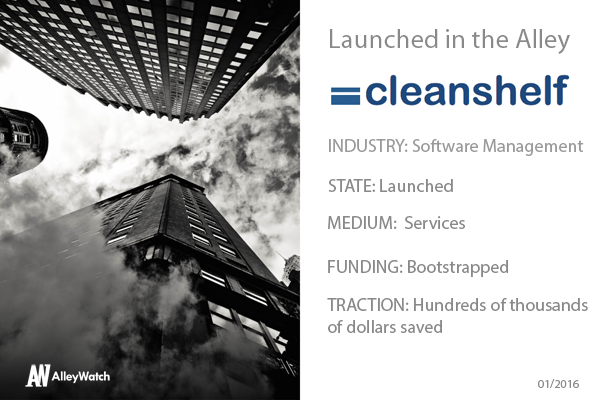
Cloud-based SaaS platforms are all the rage and startups are relying heavily on them to keep costs down and infrastructure low. However even with this growth, there is room for optimization as there is an estimated $30B wasted each year on mismatched or unused services. This is where Cleanshelf fits in. The end-to-end service is helping companies save money on their Saas spend with the own optimization platforms that measure efficiency. Their platform has already saved companies hundreds of thousands and they count companies like Parse.ly, GiveForward and Voxy as their clients.
Today, we sit down with CEO and cofounder Aron Grossman to learn more about why Cleanshelf is making a spalsh in the space as well what future looks like.
Tell us about the product or service.
Cleanshelf helps high-growth companies save money on their SaaS spend. We do so by leveraging client spend data, employee utilization information and our own proprietary SaaS database to drive actionable and material cost-savings and productivity enhancements to our clients. Cleanshelf also takes care of carrying out the actual vendor optimizations (e.g. canceling unused services, removing excess licenses, renegotiating contracts, changing service tiers, and switching to lower-cost alternatives).
How is it different?
Cleanshelf is the only pure-play provider offering an end-to-end service focusing on SaaS cost optimization. There are consultants that focus on generic cost optimizations, but the lack of specialization makes it difficult to uncover SaaS overspend, especially since the cloud landscape is evolving so rapidly. On the other side of the spectrum, there are software products that provide a dashboard of a company’s software expenses, but aren’t able to actually provide customized cost-savings recommendations, nor handle the optimizations themselves. Cleanshelf’s focus on SaaS, unique approach (and business model), and domain expertise allows it to effectively and efficiently drive significant cost savings without causing any productivity impact to its clients’ teams.

What market are you attacking and how big is it?
An estimated $30 billion is wasted on software each year in the US alone. Right now Cleanshelf’s clients are predominantly high-growth venture backed companies. However, cloud software is used by all types of companies, from mom-and-pops all the way to the largest enterprises in the world. Over time, we plan to work with larger organizations, especially as SaaS continues to comprise a bigger percentage of their IT spend.
What is the business model?
Our fee is calculated as a percentage of actual savings generated; we don’t take a retainer, and there’s no minimum fee. As a result, our incentives are always aligned with our clients.
What inspired the business?
The idea for Cleanshelf was initially borne from a pain point I experienced myself as CFO of a venture-backed company. We were paying for roughly 50 different software tools throughout the organization. Despite being close to the numbers, I had very little visibility into how our employees were engaging with and utilizing these products. We ultimately conducted a labor-intensive internal audit of all of our software tools, and uncovered that around 20% of that spend was waste. I knew that this problem couldn’t be specific to my company, and there had to be a better to address it.
On average, how much can your platform save a startup?
On average we’ve been able to save 20% of a company’s annual software spend.
What are the milestones that you plan to achieve within six months?
Today, Cleanshelf is primarily a services business, but we are constantly thinking about how to build a scalable model so that we can serve a significantly larger set of customers. Thus, our key milestones are based on serving more clients; the insights from these audits serve as the most important input into our product development process. In addition, we plan to further expand our SaaS database during this timeframe. This database, which includes both proprietary and publicly available information on the most commonly used SaaS tools plays an important role in our ability to provide unique value to our customers.
What is the one piece of startup advice that you never got?
Set goals, early and often. While it can seem difficult to employ a data-driven approach when your company is so small and the sample size of data is tiny, it’s still important to quantify your goals. It helps provide a framework to structure and organize your time (your most valuable resource), and allows you to measure your progress, which is particularly difficult in the early days.
If you could be put in touch with anyone in the New York community who would it be and why?
Michael Bloomberg. I’m a big fan of his and would love to talk to him about his experience starting and building Bloomberg into what it is today.
Why did you launch in New York?
I’ve lived in New York for over 10 years, and being a part of the flourishing NYC tech community has been really exciting; and there are so many great companies here to work with. I also have a fairly strong network in New York, and so it was great place to start. Our client base includes a number of rapidly growing NYC tech companies like Olapic and Parse.ly.
What’s your favorite rooftop bar in NYC to unwind?
It’s a bit out of the way, but Brooklyn Crab is a great place to grab a few drinks with some great views of the water. Brings me back to my New England roots.



